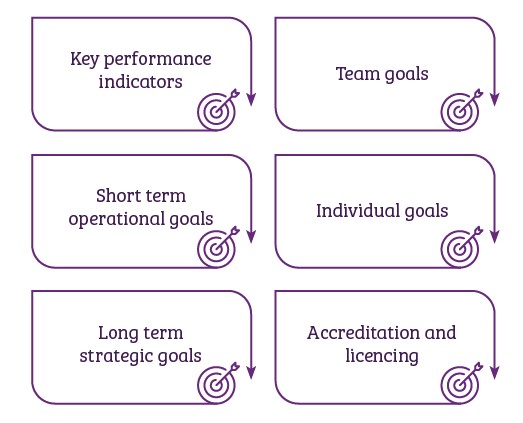Compliance in community services is an active and important area of work which should be integrated into systems of operation and continuous improvement. If your role involves monitoring and responding to issues of compliance, you will need to have a sound understanding of the requirements of the tasks and their significance.
By the end of this chapter, you will understand:
- how to respond to non-compliance
- how to maintain and update required accreditations or certifications
- how to refer breaches to others in the workplace.
Monitoring compliance can be time consuming, especially in a complex area like working with children and young people. There are strategies that you can use, however, to ensure that you comply with your requirements. For example:
Rely on Your Organisation’s Policies and Procedures
One of the main purposes of an organisation’s policies and procedures is to ensure legislative and ethical compliance. All of the information that you need to maintain and monitor compliance should be there somewhere.
Role-Model Compliance
As with so many areas, if you are a positive role model for your team and other stakeholders and exemplify compliance in everything you do, creating a culture of compliance is easier which makes managing and monitoring compliance easier too.
Plan for Compliance
Do not just wing it. Be aware of your obligations, plan ahead, schedule compliance activities and regularly review and update your plan. Build compliance into all planning activities and ensure that compliance forms a part of planning for all new projects.
Build Compliance into Performance Planning and Review
When discussing performance with members of your team, include compliance as a specific item.
Talk About Compliance
Talk about compliance in a positive way including the benefits to your clients and to each other. Include compliance as an agenda item in meetings. Discuss compliance with your team, your network, your mentor, your supervisors and your colleagues.
Setting Goals and Making Plans
It is important to set compliance goals and reward and recognise achievements. Consider areas of compliance activity in your workplace. Think about the compliance monitoring that is required for each area of operations.
You can establish short and long term goals and set benchmarks for achievement in relation to each compliance area. This can then form part of your strategic plan and your continuous improvement plan for the organisation.
You can document progress in relation to:

| Activity 4A |
|---|
| Researching Accreditation and Setting Goals Conduct research into the process of accreditation which occurs for one aspect of a community services workplace. Make notes about the process and what is required. Now consider a fictional community services organisation where the required accreditation has not been maintained. Write one short term and one long term goal that you would set for the organisation that could be used as part of their continuous improvement process. |
You can document successes as well as identify opportunities for addressing non-compliance or compliance issues in relation to these areas:
- Industrial relations
- Workplace health and safety
- Duty of care
- Anti-discrimination
- Work/role boundaries
- Accreditation requirements
- Auditing/inspections
- Workplace practices
- Legislative compliance
- Compliance in communication
| Activity 2B |
|---|
|
Compliance Monitoring Please note: The material presented in these case studies is confronting. If you feel that completing this activity may have a negative impact on your wellbeing, please speak to your trainer about making alternative arrangements before participating. In 2015, The Commission for Children and Young People conducted an inquiry into the adequacy of residential care services to children in Victoria. You will find the report at the following link: https://ccyp.vic.gov.au/assets/Publications-inquiries/as-a-good-parent-would.pdf Review the case studies in chapter five of the report and choose two to comment on. What impact might positive compliance monitoring and management have had on the children and young people described in the case studies? How might their journeys in out-of-home care been different? What could have been improved in terms of compliance and reporting for those children and young people? |
Issues and Breaches
It is almost inevitable that if you are monitoring and managing compliance effectively, you will identify issues and breaches from time-to-time. The action that you take will, of course, vary depending on the type of issue and on your organisation’s processes, policies and procedures. There are, however, some key elements of addressing issues and breaches which remain consistent:
- Responding in accordance with your organisation’s policies and procedures
- Responding in accordance with legislative requirements
- Acting in the best interests of the children and young people in your care
- Recording and reporting the issue and the actions taken to resolve it
- Following up to ensure that the actions taken have successfully resolved the issue
| Activity 2C |
|---|
|
Compliance Breaches in Action Break into groups of five or six if possible, otherwise complete this activity individually. Workshop/think about two compliance issues identified. Describe the issues, how they were identified, what the process was to report and resolve the issues, what organisational policies and procedures were involved and what was the relevant legislation. Was the issue successfully resolved? How could the issue be prevented next time? |
Depending on your work role and scope of practice, you may have responsibility for issues related to accreditation and certification.
Accreditation Requirements
In some cases, it will be your responsibility to ensure that all people coming into your service are appropriately licensed or credentialed to be there. This might include working with children checks, trade certified, first aid qualifications, police checks and so on.
Working with Children Check
According to the Worker Screening Act (2020) there are specific requirements for organisations which employ or provide volunteer opportunities to people who work with children. These vary across locations and may change over time. It is important to stay up-to-date with changes to requirements related to your requirements.
Auditing and Inspections
There are often audits and inspections that will be your responsibility to arrange. This might be WHS audits, building inspections, equipment checks, first aid kit checks and so on. You should carefully check the tasks in your position description as well as your organisation’s policies and procedures to ensure that you follow the requirements for audits and inspections.
| Activity 4D |
|---|
|
WWC Compliance Visit the Victorian government website here: https://www.workingwithchildren.vic.gov.au/about-the-check/resources Read the general information and download the resources about applying for a WWC card. Find out the time period for which a card is valid and what the process is for applying. As an organisation, what do you need to do to ensure that everyone complies with the requirements of the legislation? How do you respond if you identify non-compliance? |
Compliance can be a complicated area and it is always wise to seek specialist advice if you have an issue that you have not come across before or where the way forward is unclear. Your organisation’s policies and procedures are always a good place to start.
Leadership Roles
You can consult with your manager or team leader for advice about compliance breaches. Identify the breach, consider its implications and the need for a response then seek advice or guidance. In some cases you may need to refer to someone in a leadership role urgently, while in other cases the matter can be resolved within the normal meeting or consultative structures which exist in your workplace.
Policies and Procedures
You should always refer to your policies and procedures to establish the context for how you manage a noncompliance issue or breach first. Identify the relevant policies and procedures, then carry them out according to the specified time frames and required actions.
Other Sources of Information
You could also consider:
- Industry associations
- Specialist advisers
- Mentors
- Industry journals
- Industry newsletters
- Local government
- State government departments
- Commonwealth government departments
- Regulatory agencies
- Legislation
- Practice notes
- Specialist legal advice
The source you consult will vary depending upon the issue of non-compliance which has been identified.
| Activity 4E |
|---|
|
Consulting a Regulatory Body Imagine you are working for a small community services organisation. You have been asked to write an email to seek clarification from a regulatory body about the accreditation required for your program areas in which you operate. Write the email you would use to seek this information. You may add the details of the organisation and the names of the people involved (ensure that these are fictional). Research the name of the regulatory body relevant to your area of work and the accreditation which is required. Use appropriate and professional written communication in your email. |
| Review Questions | |
|---|---|
| Use the following questions to check your knowledge | |
| 1. | Identify one strategy you could use to ensure your team focuses on compliance./td> |
| 2. | Explain one tool you could use to measure success and give an example of it being used in action. |
| 3. | Describe three features you should include in an email you send to a regulatory body to seek clarification about an issue of compliance. |
| 4. | Describe the problem which might occur if you do not plan for compliance in your organization. |
